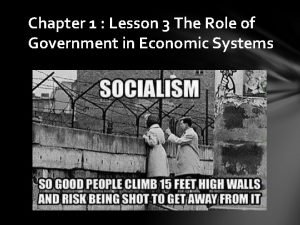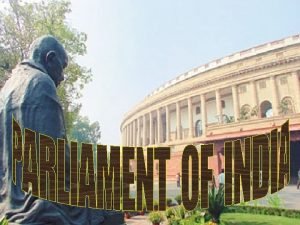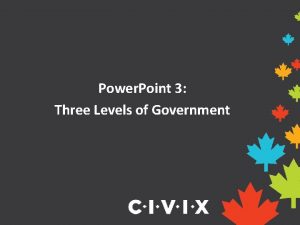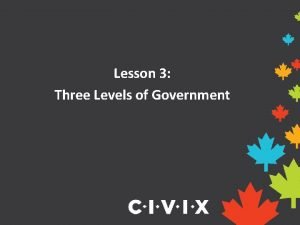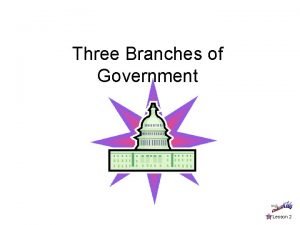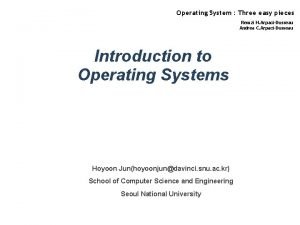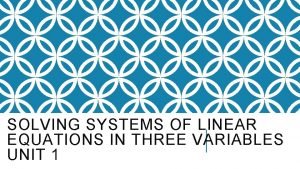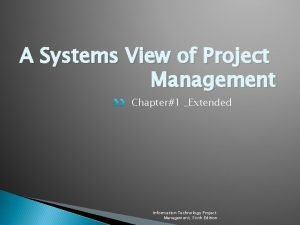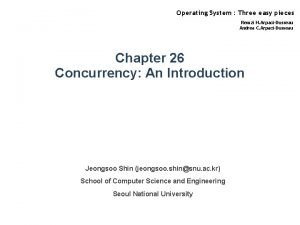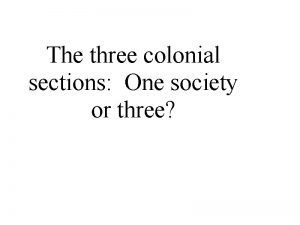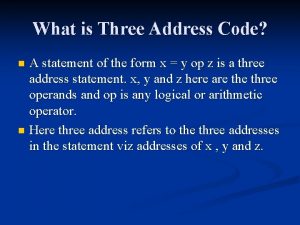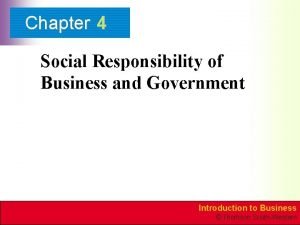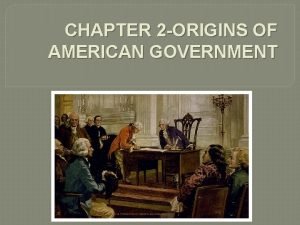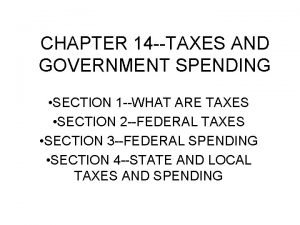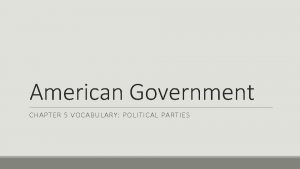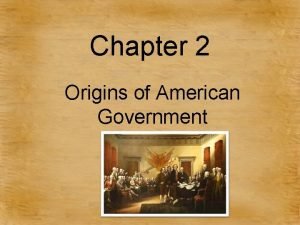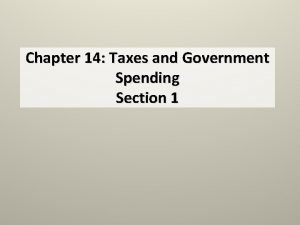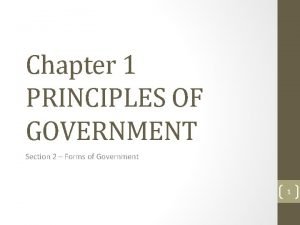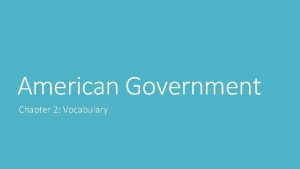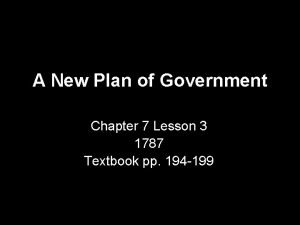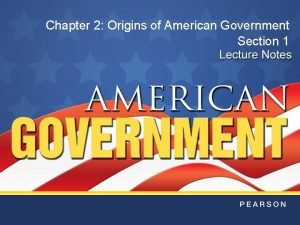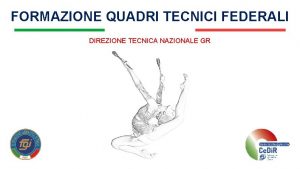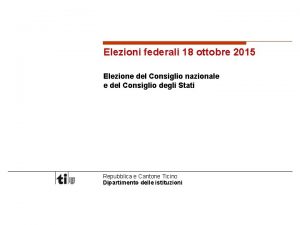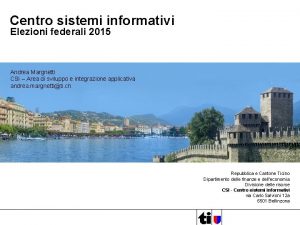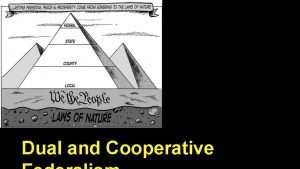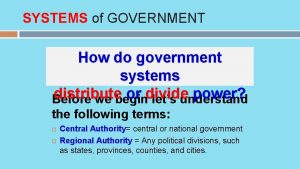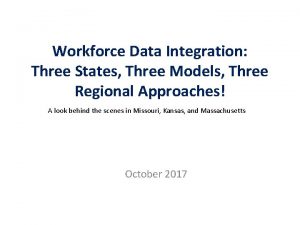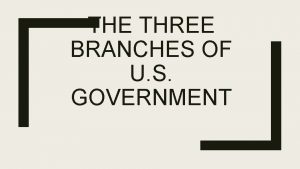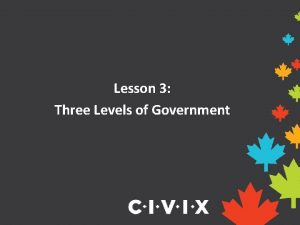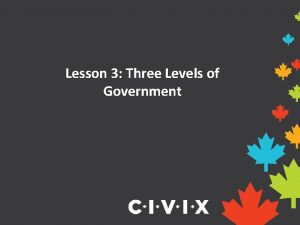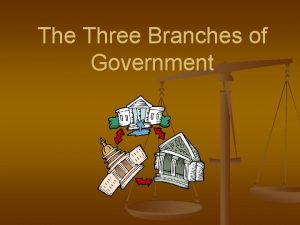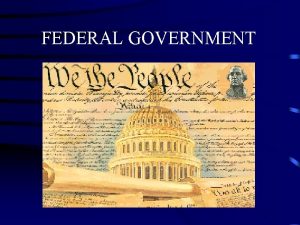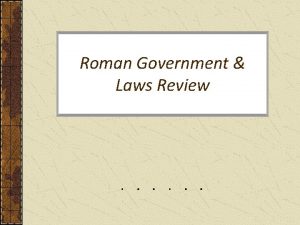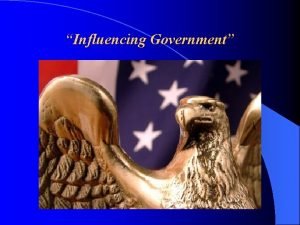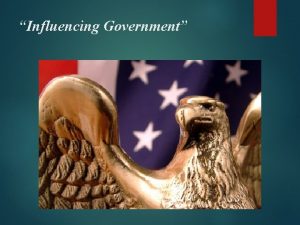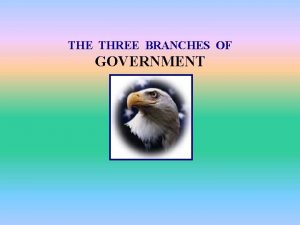FEDERALI SM CHAPTER 3 THREE SYSTEMS OF GOVERNMENT




































- Slides: 36

FEDERALI SM CHAPTER 3

THREE SYSTEMS OF GOVERNMENT 1. Unitary 1. 2. Confederate 1. 3. A centralized system which all power is vested in a central government. Ex. GB, France, China A decentralized system of government in which a weak central government has limited power over the states. Ex. United Nations Federal 1. A system in which power is divided by a written constitution between a central gov. and regional govs. Two or more levels of government have formal authority over the same area and people. Ex. USA, Mexico, Canada, Germany, India

THE CONSTITUTIONAL DIVISION OF POWERS A. THE FRAMERS CHOOSE FEDERALISM • They chose to balance order and freedom by creating a federal system that assigned powers to the national gov while reserving other powers to the states.

THE CONSTITUTIONAL DIVISION OF POWERS Ø EXPRESSED POWERS 1. Expressed powers (also called enumerated powers) are specifically granted to the federal government by the Constitution. 2. Article 1, Section 8 lists 18 separate clauses that enumerate 27 powers to Congress. Article 2, Section 2 assigns POTUS several expressed powers. Article 3 grants “the judicial power of the United States” to the Supreme Court. And finally, several amendments contain expressed powers. For example, the 16 th Amendment gives Congress the power to levy an income tax. 3. Key expressed powers 1. The power to regulate interstate and foreign commerce. 2. The power to tax and spend. 3. The war power.

THE CONSTITUTIONAL DIVISION OF POWERS • IMPLIED POWERS 1. Implied powers are not expressly stated in the Constitution. 2. Implied powers are derived from the Elastic Clause (A 1, S 8, C 18) 3. The necessary and proper clause enables the national government to meet problems the Framers could not anticipate. It thus insured the growth of national power by enabling the federal gov to extend its powers beyond those enumerated in the Constitution. 1. Mc. Culloch v. Maryland (1819) used the necessary and proper clause to create a new government power.

THE CONSTITUTIONAL DIVISION OF POWERS • INHERENT POWERS 1. Inherent powers derive from the fact that the United States is a sovereign nation. 2. Under international law, all nation-states have the right to make treaties, wage war, and acquire territory.

THE CONSTITUTIONAL DIVISION OF POWERS • RESERVED POWERS 1. Reserved powers are held solely by the states. 2. The 10 th Amendment states, “The powers not delegated to the US by the Constitution, nor prohibited by it to the states, are reserved to the states respectively, or to the people. ” 3. Examples: 1. Licensing doctors 2. Establishing public schools 3. Establishing local governments 4. Police power – the authority of a stae to protect and promote the public morals, health, safety, and general welfare.

THE CONSTITUTIONAL DIVISION OF POWERS • CONCURRENT POWERS 1. Concurrent powers are exercided by both national and state governments. • Examples: power to tax, borrow money, and establish courts. • PROHIBITED POWERS / DENIED POWERS 1. Denied Powers are denied to both the national government, state govt. , or both 2. Examples: Tax exports, and states cannot make treaties with foreign nations, and see Art. 1, Sec. 9

MILESTONES IN ESTABLISHING NATIONAL SUPREMACY • The Cardinal Question • “The relationship between the national government and the states is the cardinal question of our constitutional system. The relationship cannot be settle by one generation because it is a question of growth, and every successive stage of our political and economic development gives it a new aspect, makes it a new question. ” Woodrow Wilson

MILESTONES IN ESTABLISHING NATIONAL SUPREMACY • MCCULLOCH V. MARYLAND (1819) AND IMPLIED POWERS 1. Background of the case • Congress chartered the Second National Bank of the United States in 1816. • In 1818, the Maryland legislature passed a law imposing a substantial tax on the operation of the Baltimore branch of the bank. • James Mc. Culloch, cashier of the Baltimore branch, refused to pay the tax. • When the Maryland state courts ruled against hi, Mc. Culloch appealed to the United States Supreme Court.

MILESTONES IN ESTABLISHING NATIONAL SUPREMACY • MCCULLOCH V. MARYLAND (1819) AND IMPLIED POWERS 1. Constitutional Questions 1. Does the Constitution permit Congress to charter a bank? 2. Does a state have a constitutional right to tax an agency of the United States government? 2. SCOTUS DECISION • Although the Constitution does not specifically enumerate creating a bank, it does grant Congress the power to “make all laws necessary and proper for carrying into execution the foregoing powers. ” Congress may thus reasonably decide that chartering a national bank is a “necessary and proper” way to carry out its expressed powers.

MILESTONES IN ESTABLISHING NATIONAL SUPREMACY • MCCULLOCH V. MARYLAND (1819) AND IMPLIED POWERS 1. Significance a) Mc. Culloch v. Maryland confirmed the right of Congress to utilize implied powers to carry out its expressed powers. Federal programs to build interstate highways, regulate labormanagement relations, and inspect food and drugs are all justified as implied powers of Congress b) The decision validated the supremacy of the national gov. over the states by declaring that states cannot interfere with or tax the legitimate activities of the federal gov.

MILESTONES IN ESTABLISHING NATIONAL SUPREMACY • NULLIFICATION AND THE CIVIL WAR 1. John C. Calhoun of S. Carolina argued that a state can nullify or refuse to recognize an act of Congress that it considered unconstitutional. 2. The Civil War was both a confict over slavery and a dispute over the relationship between the Southern states and the national gov. 3. The Civil War forcibly refuted the doctrine of nullicication while also confirming that the federal union is indissoluble.

MILESTONES IN ESTABLISHING NATIONAL SUPREMACY • GIBBONS V. OGDEN (1824) AND THE COMMERCE CLAUSE 1. Background of the case 1. The New York legislature granted Aaron Ogden an “exclusive license” to run a ferry service on the Hudson River between NY and New Jersey. 2. Thomas Gibbons obtained a license from the federal government to operate a competing NY-New Jersey ferry service. 3. Ogden claimed that Gibbons infringed on the monopoly rights granted to him by the NY legislature. 4. When the NY courts ruled against him, Gibbons appealed to the SCOTUS.

MILESTONES IN ESTABLISHING NATIONAL SUPREMACY • GIBBONS V. OGDEN (1824) AND THE COMMERCE CLAUSE • Constitutional questions • Did the NY law violate the Constitution by attempting to regulate interstate commerce? • Does Congress have the exclusive right to regulate interstate commerce?

MILESTONES IN ESTABLISHING NATIONAL SUPREMACY • GIBBONS V. OGDEN (1824) AND THE COMMERCE CLAUSE 1. The Court’s decision 1. Led by John Marshall, the Sup Ct. defined commerce as all commercial business dealings. Commerce thus includes the production, buying, selling, renting, and transporting of goods, services, and properties. 2. Because congress regulates all interstate commerce, the Court upheld Gibbons’ right to operate a ferry service in competition with Ogden. 2. Significance 1. Marshall’s broad definition of commerce enabled Congress to promote economic growth by supporting the construction of roads, canals, and railroad lines.

MILESTONES IN ESTABLISHING NATIONAL SUPREMACY • THE EXPANSION OF THE COMMERCE CLAUSE 1. The commerce clause has played a key role in the expansion of federal power. 2. The national government now regulates a wide variety of commercial activities, including radio signals, telephone messages, and financial transactions. 3. The SCOTUS upheld the 1964 Civil Rights Act forbidding discrimination in places of public accommodation such as restaurants and hotels on the basis of its power to regulate interstate commerce.

MILESTONES IN ESTABLISHING NATIONAL SUPREMACY • THE STRUGGLE OVER SCHOOL DESEGREGATION 1. In 1954, in Brown v. Board of Ed, SCOTUS unanimously held that school segregation was unconstitutional. 2. President Eisenhower sent federal troops to Little Rock’s Central High School to enforce court-ordered desegregation. 3. Despite initial resistance, national standards of racial equality ultimately prevailed.


INTERGOVERNMENTAL RELATIONS • DUAL FEDERALISM • A system of government in which the national and state governments remain supreme within their own spheres. For example, the nat’l gov. is responsible foreign policy, while the states have exclusive responsibility for the public schools. • Often called “layer cake” federalism. It characterized the relationship between the national and state govts. Until the advent of the New Deal during the 1930’s.

INTERGOVERNMENTAL RELATIONS • COOPERATIVE FEDERALISM • A system of government in which the national and state governments work together to complete projects. For, example, the interstate highway program features a partnership in which national and state governments share costs and administrative duties. • Often called “layer cake” federalism because of the blurred distinction between the levels of government.




INTERGOVERNMENTAL RELATIONS • FISCAL FEDERALISM • Refers to the pattern of spending, taxing, and providing grants in the federal system. • In 2010, state and local governments received about $480 billion in federal grants. These grants accounted for about 21% of all funds spent by state and local governments. • Fiscal federalism can be classified in three major program areas: 1. Categorical grants (project and formula) 2. Block grants 3. Revenue sharing

CATEGORICAL GRANTS • Categorical grants are defined as federal aid that meets the criteria of a specific category and has specific criteria attached to them. These criteria can range from nondiscriminatory practice to minimum wages. • Two Types of Categorical grants • Project grants – are based on competitive applications by states and individuals • Formula grants – which are based on specific formulas developed by Congress.

BLOCK GRANTS • Block grants are a form of federal aid with far fewer strings attached. Made for broadly defined purpose. They go to local communities for specific purposes, and the states decide where and how to spend the money. i. e. homeland security and community development.

REVENUE SHARING • Gives money directly to the states with no strings attached. • Richard Nixon used revenue sharing to reverse the policies of LBJ. • The Clean Air Act of 1970 – set national standards for air quality but directed the states to implement the law and enforce it.

MANDATES A mandate is a rule telling states what they must do to comply with federal guidelines. Civil rights and environmental protection are the most common mandates. For example, state programs may not discriminate against people because of their race, se, age, or ethnicity. An unfunded mandate requires state and local governments to provide services without providing resources for the services • i. e. Handicapped Children’s Protection Act required public schools to build access ramps and provide special buses, but the act did not provide federal funds to pay for these additions.

DEVOLUTION Refers to a movement to transfer responsibilities of governing from the federal government to state and local governments. For example, the Welfare Reform Act of 1996 gave the states the money to run their own welfare programs. States had wide discretion in implementing the federal goal of transferring people from welfare to work. • “Contract with America“ – In the 1994 congressional elections, Congressman Newt Gingrich had Republican candidates sign a document in which they pledged their support for such things as a balanced budget amendment, term limits for members of Congress, and a middle-class tax cut.

CONTRACT WITH AMERICA 1994

DEVOLUTION • Devolution proponents harbor a deep-seated ideological mistrust of federal government and believe that state governments are more responsive to the people • Deficit politics encouraged devolution (NATIONAL DEBT!) www. usdebtclock. org • Devolution is supported by public opinion, but the strength of that support is uncertain


ADVANTAGES AND DISADVANTAGES OF FEDERALISM • ADVANATAGES 1. Promotes diverse policies that encourage experimentation and creative ideas. 2. Provides multiple power centers, thus making it difficult for any one faction or interest group to dominate government policies. 3. ENCOURAGES PARTICIPATION by keeping the government close to the people.

ADVANTAGES AND DISADVANTAGES OF FEDERALISM • DISADVANTAGES 1. Promotes inequality because states differ in the resources they can devote to providing services. 2. Enables local interests to delay or even thwart majority support for a policy. 3. Creates confusion because the different levels of government make it difficult for citizens to know what different governments are doing.

 Three branches of government flocabulary answers
Three branches of government flocabulary answers National powers
National powers Lesson 3 the role of government in economic systems
Lesson 3 the role of government in economic systems 3 branches of government quiz
3 branches of government quiz Name the three organs of the government
Name the three organs of the government What are the three levels of government
What are the three levels of government What are the three levels of government
What are the three levels of government Civix lesson plans
Civix lesson plans Lesson 2 the three branches of government
Lesson 2 the three branches of government Decision support systems and intelligent systems
Decision support systems and intelligent systems Dicapine
Dicapine Embedded systems vs cyber physical systems
Embedded systems vs cyber physical systems Elegant systems
Elegant systems Remzi h arpaci-dusseau
Remzi h arpaci-dusseau Creatine phosphate energy system
Creatine phosphate energy system The three economic systems
The three economic systems Practice 3-6 systems with three variables
Practice 3-6 systems with three variables Three ways to solve systems of equations
Three ways to solve systems of equations System view of project management
System view of project management Operating systems three easy pieces solution
Operating systems three easy pieces solution Orc and hobbit problem
Orc and hobbit problem Othello act three scene three
Othello act three scene three In three minutes write three things
In three minutes write three things Orange diamond-shaped signs warn the motorist of
Orange diamond-shaped signs warn the motorist of The three colonial sections-one society or three
The three colonial sections-one society or three Three address code examples
Three address code examples Chapter 4 social responsibility of business and government
Chapter 4 social responsibility of business and government Chapter 2 american government
Chapter 2 american government Chapter 14: taxes and government spending section 1
Chapter 14: taxes and government spending section 1 Us government chapter 5 vocabulary
Us government chapter 5 vocabulary Origins of american government chapter 2
Origins of american government chapter 2 Chapter 14 taxes and government spending
Chapter 14 taxes and government spending Chapter 1 principles of government
Chapter 1 principles of government Foundations of government guided reading activity section 1
Foundations of government guided reading activity section 1 Chapter 2 origins of american government vocabulary
Chapter 2 origins of american government vocabulary Lesson 3 a new plan of government answer key
Lesson 3 a new plan of government answer key Chapter 2 origins of american government answer key
Chapter 2 origins of american government answer key


